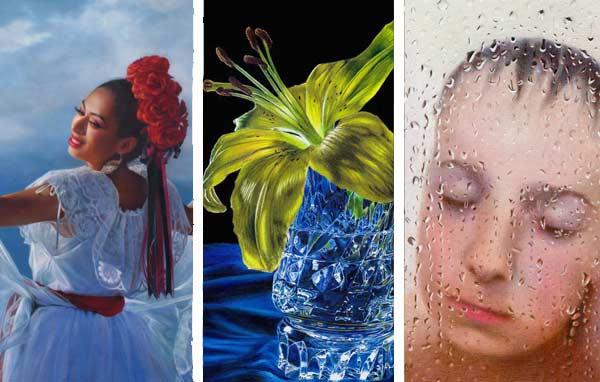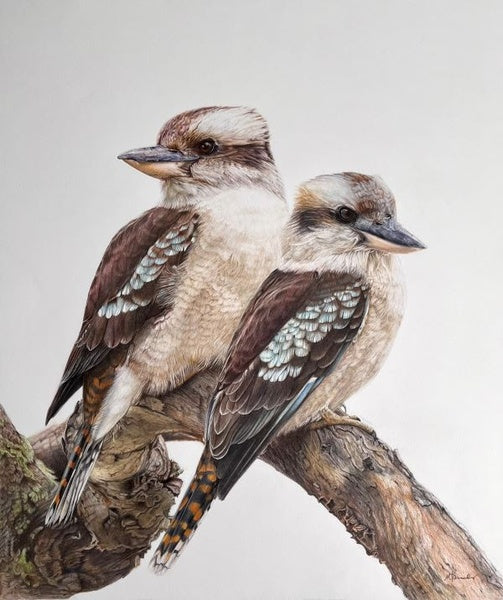Colored Pencil—Getting That Feeling of Flow
by Kylie Carney
I have loved art in its various forms since I was in primary school. One of my favourite possessions as a child was my Derwent Studio pencils—I still have a distinct memory of the cedar! Art has been something that I have dipped in and out of over the years, at times with long periods of not making art followed by intense periods of creativity. Nowadays, I am an occupational therapist working in mental health in my own private practice, but I would love to someday make art a full-time career.
Pink Roses (2021) 15" x 9". Prismacolor, Polychromos, Luminance, Derwent Lightfast, Pablos and Holbeins on Tan Pastelmat.
My adventure with colored pencils started in 2016. I was inspired by Ann Swan’s book “Botanical Portraits with Coloured Pencil”. Trying a few demonstration projects from the book, I found I enjoyed the level of control and subtlety that I could produce with the pencils, and I bought my first set of colored pencils — the 120 pack of Faber-Castell Polychromos. Over the years, I have added Prismacolor Premiere, Caran D'Ache Luminance, Caran D'Ache Pablo, Derwent Lightfast and Holbein to my collection.
“My style is quite realistic yet dramatic, and an essential part of this is getting the tonal values correct.”
Initially I worked mainly from stock photos from websites such as pixabay.com, however as I progressed, I wanted to develop original art that was truly mine. I found enormous enjoyment in taking photos of flowers, in particular at the two botanic gardens, and the rose gardens at the iconic New Farm Park, both in my hometown of Brisbane. I spend hours editing photos on an iPad to capture a dramatic viewpoint and create high levels of tonal contrast and intense colors.
Over time, my style has evolved. I have moved away from traditional delicate, “pretty” colored pencil drawings to a style that in some ways resembles an oil painting, with heavy coverage of colored pencil, with little if any tooth of the surface visible. I will typically use either a colorless blender or a solvent such as odorless mineral spirits or Zest-It to blend and create a painted effect.
I use a variety of surfaces (most commonly Fabriano Artistico HP watercolor paper, Stonehenge paper or Pastelmat) but I always cover the entire tooth of the surface, glazing with many layers of colored pencil to create subtle, rich colors.
Blushing (2021) 16.5" x 12". Prismacolor, Polychromos, Luminance, Derwent Lightfast, Pablos and Holbeins on Fabriano Artistico.
“I strongly believe that art and other creative activities are immensely valuable in promoting our mental and spiritual well-being”
My style is quite realistic yet dramatic, and an essential part of this is getting the tonal values correct. Many new colored pencil artists are hesitant to go too dark in the tonal values, however for the lightest lights to ‘pop’, a strong tonal contrast is needed, and this means using the darkest tonal values. One exceptionally useful tool I have discovered is the ‘Arty’ app for iPhone or iPad by Andrew Drizen (free on the Apple Store). Arty imports a photo into the app to use as a reference, and it has a few functions I use regularly, including a grid overlay to help with creating an initial outline, and (most importantly) a color picker which allows you to match colors in the photo reference with colors in the Polychromos, Prismacolor and Luminance ranges. Using Arty has helped me better see values, and in particular, to not be afraid to use dark tonal values. For example, for the foliage in artworks such as “Sundrenched Rose” and “Blushing”, I typically push the background almost to black, using a combination of Luminance Dark Indigo, Luminance Dark Sap Green and Luminance Crimson Aubergine overlaid on each other with quite heavy intensity and blended with solvent. Similarly, in “Pink Roses — New Farm Park” many of the colors that a superficial glance might read as ‘pale pink’ are in fact combinations of Prismacolor Henna, Crimson Lake, Pomegranate and Permanent Red, with Luminance White, Pink White and Burnt Sienna used only in the lightest parts of the petals where the sunlight is hitting.

Sundrenched Rose, New Farm Park (2021)
Working with colored pencil is an immensely slow process — a typical colored pencil drawing will take me 20 to 30 hours. It requires the ability to truly look at the subject and record what is actually there, not what we think should be there. This process of observing and translating shapes and colors into a drawing for me is very mindful. I have found the process of creating colored pencil art to bring about in me a state of ‘flow’ — what Csikszentmihalyi (a prominent researcher in the area) refers to as “a state in which people are so involved in an activity that nothing else seems to matter; the experience is so enjoyable that people will continue to do it even at great cost, for the sheer sake of doing it” (1990). As an occupational therapist, I strongly believe that art and other creative activities are immensely valuable in promoting our mental and spiritual well-being, and my personal experience reflects this.
About Kylie Carney:
Kylie Carney is a self-taught coloured pencil artists who also dabbles in pastel and water color. Her main subjects are still life, food and flowers. Kylie lives in Brisbane and draws inspiration from the numerous parks and gardens in the area. The challenges of rendering tiny details, textures, and reflections to create realism are what Kylie finds the most satisfying in her artwork. Kylie is a mental health occupational therapist. One day, she would love to make art a full time career.
See more at: https://www.instagram.com/kylie.carney/




